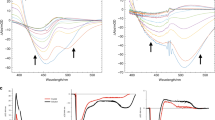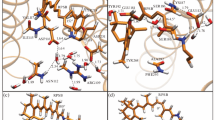Abstract.
Photoactive yellow protein (PYP) is a prototype of the PAS domain superfamily of signaling proteins. The signaling process is coupled to a three-state photocycle. After the photoinduced trans-cis isomerization of the chromophore, 4-hydroxycinnamic acid (pCA), an early intermediate (pR) is formed, which proceeds to a second intermediate state (pB) on a sub-millisecond time scale. The signaling process is thought to be connected to the conformational changes upon the formation of pB and its recovery to the ground state (pG), but the exact signaling mechanism is not known. Experimental studies of PYP by solution NMR and X-ray crystallography suggest a very flexible protein backbone in the ground as well as in the signaling state. The relaxation from the pR to the pB state is accompanied by the protonation of the chromophore's phenoxyl group. This was found to be of crucial importance for the relaxation process. With the goal of gaining a better understanding of these experimental observations on an atomistic level, we performed five MD simulations on the three different states of PYP: a 1 ns simulation of PYP in its ground state [pG(MD)], a 1 ns simulation of the pR state [pR(MD)], a 2 ns simulation of the pR state with the chromophore protonated (pRprot), a 2 ns simulation of the pR state with Glu46 exchanged by Gln (pRGln) and a 2 ns simulation of PYP in its signaling state [pB(MD)]. Comparison of the pG simulation results with X-ray and NMR data, and with the results obtained for the pB simulation, confirmed the experimental observations of a rather flexible protein backbone and conformational changes during the recovery of the pG from the pB state. The conformational changes in the region around the chromophore pocket in the pR state were found to be crucially dependent on the strength of the Glu46-pCA hydrogen bond, which restricts the mobility of the chromophore in its unprotonated form considerably. Both the mutation of Glu46 with Gln and the protonation of the chromophore weaken this hydrogen bond, leading to an increased mobility of pCA and large structural changes in its surroundings. These changes, however, differ considerably during the pRGln and pRprot simulations, providing an atomistic explanation for the enhancement of the rate constant in the Gln46 mutant.
Similar content being viewed by others

Author information
Authors and Affiliations
Additional information
Electronic Publication
Electronic supplementary material
Rights and permissions
About this article
Cite this article
Antes, I., Thiel, W. & van Gunsteren, W.F. Molecular dynamics simulations of photoactive yellow protein (PYP) in three states of its photocycle: a comparison with X-ray and NMR data and analysis of the effects of Glu46 deprotonation and mutation. Eur Biophys J 31, 504–520 (2002). https://doi.org/10.1007/s00249-002-0243-1
Received:
Revised:
Accepted:
Issue Date:
DOI: https://doi.org/10.1007/s00249-002-0243-1



